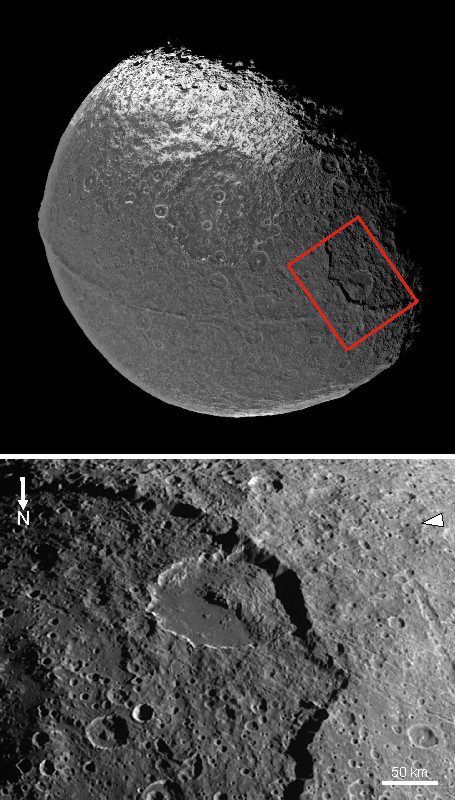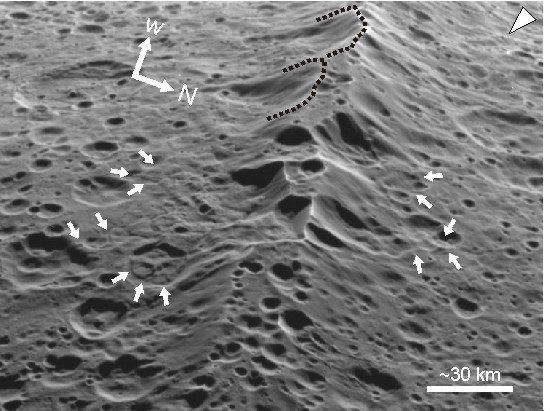Kelsi Singer • Oct 01, 2012
Sturzstroms on Saturn's Moon Iapetus
Editor's note: This entry originally appeared on the Planetary Geomorphology Image of the Month, a monthly blog feature maintained by the International Association of Geomorphologists Planetary Geomorphology Working Group. I occasionally repost these features because they are written by the geologists who are discovering and explaining cool landforms across the solar system. I have edited it to make it more accessible to non-geomorphologists. -- Emily Lakdawalla
Typical landslides run out about once or twice as far as the distance that they fall. But some landslides, called "long-runout" landslides or "sturzstroms," can extend 20 to 30 times the height they dropped from. Sturzstroms are found across the Solar System. They have been observed primarily on Earth and Mars, but also on Venus, and Jupiter's moons Io and Callisto. Here is an Earth sturzstrom:

Iapetus is the third largest moon of Saturn. The low density indicates that it is mostly composed of ice, with only a small (~20%) amount of rocky materials. Recently, I worked with a group of scientists to identify about 30 long-runout landslides, and published a paper about them in Nature Geoscience. These landslides occur in smaller craters, large impact basin rims (rising higher than 10 km in some cases), and from the unique equatorial ridge.
We identified the landslides based on three characteristics. First, the landslides themselves often had a distinct surface texture compared to the surrounding terrain, either hummocky (called blocky-type landslides) or relatively smooth and uncratered (called lobate). Here are examples of both types:


A second indicator that these are landslides is that their frontal or lateral edges often appear as a distinct border, and in some cases they are quite steep.
Third, the landslides are often associated with an adjacent alcove on the crater wall or structural ridge from which they fell. You can see those alcoves in this image of Iapetus' equatorial ridge:

Landslides on Iapetus are the largest and most numerous observed on any icy body, and they rival the longest runout landslides seen elsewhere in the Solar System (up to 80 km). So, why are there so many landslides on Iapetus?
One important factor is the extreme topography. No other body that is similar in size to Iapetus has such a wide range of elevations. The antiquity of the surface also plays a role. A long history of impacts, without resurfacing from other geological processes, would leave an uppermost surface that was pulverized and not well consolidated. The surface therefore has slopes that are only barely stable and which can be triggered to fail over time. Sturzstroms are most likely triggered by impacts elsewhere on Iapetus.
Typical height-to-length ratios of landslides on Iapetus lie between 0.1 and 0.3. Terrestrial submarine landslides and mudflows have low coefficients of friction and height-to-length ratios of around 0.1. Small subaerial rock avalanches on Earth and large landslides on Mars have higher coefficients of friction and have height-to-length ratios closer to 0.3. The frictional properties of the Iapetus landslides were smaller than one would predict for an icy body.
Many theories have been proposed to explain a reduction of friction in large-runout landslides (such as acoustic fluidization or mobilization on an air cushion). The mechanism proposed for Iapetus is flash heating along the base of the landslides. This process produces a concentrated amount of heating -- not enough to melt ice, but sufficient to increase lubrication and make the ice more slippery.
Earth and a small icy satellite such as Iapetus may seem very dissimilar. But the same geomorphic processes operate on both worlds. A better understanding of the long landslides on Iapetus may help us to understand the causes of similar catastrophic events on our own planet.
Further reading:
Icy Satellites:
- Dombard, A.J., Cheng, A.F., McKinnon, W.B. & Kay, J.P. (2012) Delayed formation of the equatorial ridge on Iapetus from a sub-satellite created in a giant impact. J. Geophys. Res. 117, 03002.
- Moore, J. M. et al. (1999) Mass movement and landform degradation on the icy Galilean satellites: Results of the Galileo Nominal Mission. Icarus 140, 294–312.
- Singer, K.N., McKinnon, W.B., Schenk, P.M., and Moore, J.M. (2012) Massive ice avalanches on Iapetus caused by friction reduction during flash heating. Nature Geoscience, 5, 8, pp. 574 - 578.
Mars:
- McEwen, A. S. (1989) Mobility of large rock avalanches: Evidence from Valles Marineris, Mars. Geology 17, 1111–1114.
- Quantin, C., Allemand, P. & Delacourt, C. (2004) Morphology and geometry of Valles Marineris landslides. Planet. Space Sci. 52, 1011–1022.
- Friction reduction on Earth from flash heating (landslides and faults):
- De Blasio, F. V. & Elverhøi, A. (2008) A model for frictional melt production beneath large rock avalanches. J. Geophys. Res. 113, F02014.
- Di Toro, G. et al. (2011) Fault lubrication during earthquakes. Nature 471, 494–498.
- Goldsby, D.L., & Tullis, T.E. (2011) Flash heating leads to low frictional strength of crustal rocks at earthquake slip rates. Science 334, 216–218.
General:
- Rosenberg, R. (2005) Why is ice slippery? Physics Today 58, 50–55.
- Melosh, H. J. (2011) Planetary Surface Processes. Cambridge Univ. Press.
Support our core enterprises
Your support powers our mission to explore worlds, find life, and defend Earth. You make all the difference when you make a gift. Give today!
Donate

 Explore Worlds
Explore Worlds Find Life
Find Life Defend Earth
Defend Earth

